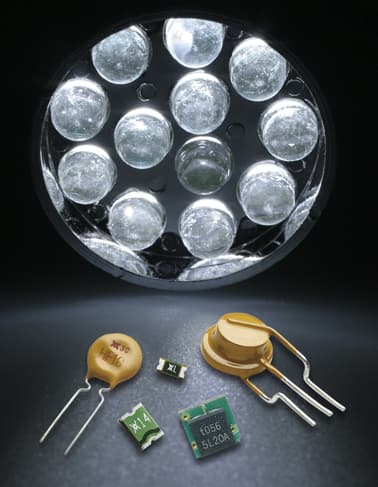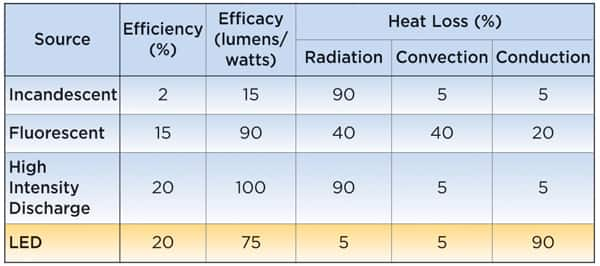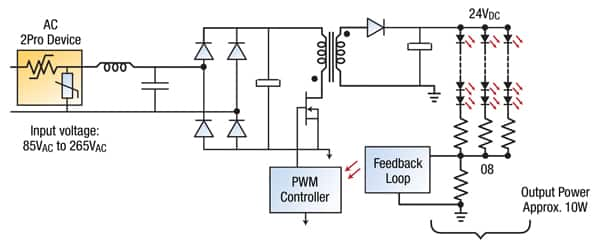Coordinated Circuit Protection for LED Lighting
投稿人:Convergence Promotions LLC
2011-11-22
LED thermal management is critical to proper color rendition as well as safe operation. While designers pay a lot of attention to power management to control overheating, do not overlook over-voltage and over-current protection.

In spite of the growing popularity of the technology, however, LED manufacturers continue to wrestle with the fact that without adequate thermal management, heat can degrade the LED’s lifespan and affect color output. Also, since LED drivers are silicon devices, they can fail short. This means fail-safe backup overcurrent protection may be necessary.
LED technology has advanced rapidly, with improved chip designs and materials facilitating the development of brighter and longer-lasting light sources that can be used in a wide spectrum of applications. Nevertheless, LED luminaires require precise power and heat-management systems, since most of the electrical energy supplied to an LED is converted to heat rather than light.
Resettable polymeric positive temperature coefficient (PPTC) devices have demonstrated their effectiveness in a variety of LED lighting applications. Like traditional fuses, they limit current after specified limits are exceeded. However, unlike fuses, PPTC devices have the ability to reset after the fault is cleared and the power is cycled.
A variety of overvoltage protection devices including metal oxide varistors (MOVs), electrostatic discharge (ESD) surge protection devices, and polymer-enhanced Zener diodes can be used in a coordinated scheme with PPTC devices to help improve LED performance and reliability.
Heat conduction comparisons
A lighting fixture using a 60 W incandescent light bulb produces approximately 900 lumens of light and must dissipate 3 W of heat via conduction. In comparison, using typical DC-LEDs as the light source to achieve the same 900 lumens would require about 12 LEDs. Assuming a VF (forward voltage) of 3.2 V and current of 350 mA, the input power to the LED fixture could be calculated as:
Power = 12 x 3.2 V x 350 mA = 13.4 W
In this scenario, approximately 20 percent of the input power is converted to light and 80 percent to heat; dependent on various factors and heat-generation that can be related to substrate irregularities, as well as phonon emissions, binding, materials used, etc.
Of the total heat generated by the LED, 90 percent is transferred via conduction. Figure 1 shows that, to dissipate heat from the junction of an LED, conduction is the principle channel of transfer since convection and radiation only account for about 10 percent of overall heat transfer. For example, an LED may convert close to 10.72 W of heat (13.4 W x 0.80). Of this, 9.648 W (10.72 W x 0.90) of heat is transferred or removed from the junction via conduction.

Figure 1: Heat dissipation comparison of various light sources.
Junction temperature effect
The optical behavior of an LED varies significantly with temperature. The amount of light emitted by the LED decreases as the junction temperature rises and, for some technologies, the emitted wavelength changes with temperature. If drive current and junction temperature are not properly managed, the LED’s efficiency can drop quickly, resulting in reduced brightness and shortened life.
Another LED characteristic, related to junction temperature, is the forward voltage of the LED (Figure 2). If only a simple bias resistor is used to control the drive current, VF drops as temperature rises and the drive current increases. This can lead to thermal runaway, especially for high-power LEDs, and cause the component to fail. It is common practice to control junction temperature by mounting the LEDs on metal core PCBs to provide rapid heat transfer.

Figure 2: Forward voltage drops as junction temperature rises.
Power line coupled transients and surges can also reduce LED lifespan and many LED drivers are susceptible to damage resulting from improper DC voltage levels and polarity. LED driver outputs may also be damaged or destroyed by short circuits. Most LED drivers include built-in safety features, including thermal shutdown, as well as open and short LED detection. However, additional overcurrent protection devices may be needed to help protect integrated circuits (ICs) and other sensitive electronic components.
LED driver input and output protection
LEDs are driven with a constant current, with the forward voltage varying from less than 2 V to 4.5 V, depending on the color and current. Older designs relied on simple resistors to limit LED drive current, but designing an LED circuit based on the typical forward voltage drop as specified by a manufacturer can lead to overheating of the LED driver.
Overheating may occur when the forward voltage drop across the LED decreases to a value significantly less than the typical stated value. During such an event, the increased voltage across the LED driver can result in higher total power dissipation from the driver package.
Today, most LED applications utilize power conversion and control devices to interface with various power sources (i.e., the AC line, a solar panel or battery power) to control power dissipation from the LED driver. Protecting these interfaces from overcurrent and overtemperature damage is frequently accomplished with resettable PPTC devices.
The PPTC device has a low-resistance value under normal operating currents. In the event of an overcurrent condition, the device “trips” into a high-resistance state. This increased resistance helps protect the equipment in the circuit by reducing the amount of current that can flow under the fault condition to a low, steady-state level. The device remains in its latched position until the fault is cleared. Once power to the circuit is cycled, the PPTC device resets and allows current flow to resume, restoring the circuit to normal operation.
Figure 3 illustrates a coordinated protection scheme for switch-mode power supplies (SMPSs) and LED driver inputs and outputs. As shown on the left-hand side of the figure, a PPTC device, such as a resettable PolySwitch™ device, can be installed in series with the power input to help protect against damage resulting from electrical shorts, overloaded circuits or customer misuse. Additionally, an MOV placed across the input helps provide overvoltage protection in the LED module.
The PPTC device may also be placed after the MOV. Many equipment manufacturers prefer protection circuits combining resettable PPTC devices with upstream fail-safe protection. In this example, R1 is a ballast resistor used in combination with the protection circuit.
LED drivers may be susceptible to damage resulting from improper DC voltage levels and polarity. Outputs may also be damaged or destroyed by an inadvertent short circuit. Powered ports are also susceptible to damaging overvoltage transients, including ESD pulses.
The right side of Figure 3 shows a coordinated circuit protection design for an LED driver and bulb array. A PolyZen device placed on the driver input offers designers the simplicity of a traditional clamping diode while obviating the need for significant heat sinking. Developed by TE Circuit Protection, this device’s unique polymer-protected precision Zener design helps provide transient suppression, reverse bias protection and overcurrent protection in a single, compact package.
As shown in Figure 3, a PolySwitch PPTC device on the driver output can help protect against damage caused by inadvertent short circuits or other load anomalies. To fully leverage the PolySwitch device, it can be thermally bonded to the metal core circuit board or LED heat sink. To help prevent damage caused by an ESD event, protection devices such as TE Circuit Protection’s low-capacitance, small-form-factor PESD devices can be placed in parallel with the LEDs.

AC mains LED lighting protection
MOVs are typically used for transient overvoltage suppression in AC line-voltage applications. Under normal operating conditions the AC line voltage applied to an MOV is not expected to exceed the device’s maximum AC root mean voltage (VAC RMS) rating and, provided that the transient energy does not exceed the MOV’s maximum rating, short-duration transient events are clamped to a suitable voltage level. However, a sustained abnormal overvoltage/limited current condition, such as a loss of neutral, may cause the MOV to go into thermal runaway.
New thermally-enhanced MOVs help protect a wide variety of low-power systems against damage caused by overcurrent, overtemperature and overvoltage faults, including lightning strikes, ESD surges, loss of neutral, incorrect input voltage and power induction. Figure 4 shows how TE Circuit Protection’s 2Pro device helps provide this integrated protection for AC mains LED lighting systems.

The 2Pro device combines PPTC technology with an MOV component into one thermally protected device to help provide resettability in case of overcurrent or overvoltage events. This integrated-device approach was developed to help manufacturers meet industry requirements, such as IEC61000-4-5 and IEC60950.
Summary
A coordinated circuit protection scheme can help LED lighting designers reduce component count, provide a safe and reliable product, comply with regulatory agency requirements, and reduce warranty and repair costs. As with any circuit protection scheme, the effectiveness of a solution will depend on the individual layout, board type, specific components, and unique design considerations. TE Circuit Protection works with OEM customers to help identify and implement the best approach.

免责声明:各个作者和/或论坛参与者在本网站发表的观点、看法和意见不代表 DigiKey 的观点、看法和意见,也不代表 DigiKey 官方政策。





